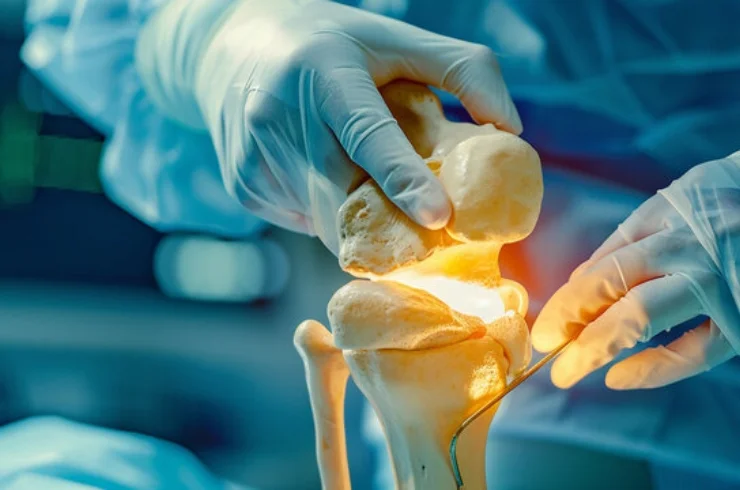Joint Replacement Surgery

Joint Replacement Surgery: Restoring Mobility and Relieving Pain
Overview
Joint replacement surgery, also known as arthroplasty, is a highly effective procedure designed to relieve pain, restore joint function, and improve the quality of life for individuals with joint degeneration, arthritis, or other joint-related disorders. The surgery involves replacing a damaged or worn-out joint with an artificial implant (prosthesis), which can be made from materials such as metal, plastic, or ceramic. Joint replacement is most commonly performed on weight-bearing joints, including the hip, knee, shoulder, and elbow, but can also be done on other joints such as the ankle or wrist.
Indications for Joint Replacement Surgery
The need for joint replacement typically arises when conservative treatments like medication, physical therapy, or injections no longer provide relief, and the joint condition severely affects daily activities. Common conditions that may require joint replacement surgery include:
Osteoarthritis: A degenerative condition where the cartilage in the joint deteriorates, leading to pain, stiffness, and limited mobility.
Rheumatoid Arthritis: An autoimmune disorder causing inflammation and damage to the joints, leading to joint deformities and pain.
Post-Traumatic Arthritis: Arthritis that develops after a significant injury or trauma to a joint.
Avascular Necrosis: A condition in which the blood supply to a joint is disrupted, leading to bone death and eventual joint collapse.
Joint Deformities or Fractures: Severe deformities or fractures that are not amenable to other surgical repairs may require joint replacement.
Types of Joint Replacement Surgery
Hip Replacement (Hip Arthroplasty): One of the most common joint replacement procedures, hip replacement involves replacing the damaged hip joint with a prosthetic implant to relieve pain and improve mobility.
Knee Replacement (Knee Arthroplasty): In knee replacement, the damaged knee joint is replaced with an artificial joint, typically made of metal and plastic, to restore function and relieve pain.
Shoulder Replacement (Shoulder Arthroplasty): Shoulder replacement involves replacing the damaged parts of the shoulder joint with a prosthesis, often due to arthritis or severe rotator cuff injuries.
Elbow Replacement (Elbow Arthroplasty): In elbow replacement, the damaged elbow joint is replaced with a prosthetic implant, commonly performed for conditions like arthritis, fractures, or deformities.
Ankle Replacement (Ankle Arthroplasty): Involves replacing a damaged ankle joint with a prosthesis, typically performed for arthritis or severe injury.
Wrist and Finger Joint Replacement: In certain cases of arthritis or joint deformities, wrist or finger joint replacement surgeries are performed to restore function.
Procedure
The procedure for joint replacement typically involves the following steps:
Anesthesia: The surgery is performed under general anesthesia or regional anesthesia, depending on the joint being replaced and the patient’s health.
Removal of Damaged Joint: The surgeon makes an incision and removes the damaged cartilage and bone from the joint.
Insertion of Prosthesis: The damaged joint is replaced with a prosthetic implant designed to mimic the natural function of the joint. The components are typically secured with bone cement or, in some cases, a cementless design that allows the bone to grow into the prosthesis.
Closure and Recovery: Once the implant is in place and the joint is properly aligned, the incision is closed with sutures or staples. A sterile dressing is applied, and the patient is taken to the recovery room.
Recovery and Rehabilitation
Post-surgery recovery varies depending on the joint replaced and the individual’s health condition. In general, recovery includes:
Hospital Stay: Most patients stay in the hospital for a few days after surgery for pain management, monitoring, and initial rehabilitation.
Physical Therapy: Rehabilitation is an integral part of recovery. Physical therapy begins soon after surgery to help restore joint mobility, strength, and function. This may involve exercises, joint mobilizations, and stretching routines to promote healing.
Assistive Devices: Patients may need to use crutches, walkers, or canes for support in the early stages of recovery to avoid putting too much weight on the joint.
Full Recovery: While some patients may return to normal activities within a few weeks, full recovery typically takes several months, depending on the joint involved and the patient’s progress.
Benefits of Joint Replacement Surgery
Pain Relief: The most significant benefit of joint replacement is the relief from chronic pain caused by arthritis, trauma, or other joint conditions.
Improved Mobility and Function: Joint replacement restores mobility and function, allowing patients to return to everyday activities such as walking, climbing stairs, and participating in recreational activities.
Enhanced Quality of Life: With improved function and reduced pain, patients often experience a better quality of life, greater independence, and a return to hobbies and social activities.
Risks and Complications
While joint replacement surgery is generally safe and highly effective, it carries some risks, including:
- Infection
- Blood clots
- Nerve or blood vessel damage
- Implant loosening or wear over time
- Stiffness or reduced range of motion
However, these risks are relatively rare, and advancements in surgical techniques and prosthetic materials have significantly improved the safety and success of joint replacement surgeries.
Conclusion
Joint replacement surgery is a transformative procedure for individuals suffering from chronic joint pain and dysfunction due to arthritis, injury, or degeneration. With advancements in surgical techniques, prosthetic designs, and rehabilitation methods, joint replacement offers patients significant relief, improved mobility, and a better quality of life. For many individuals, joint replacement is the key to regaining independence, staying active, and returning to normal activities.

